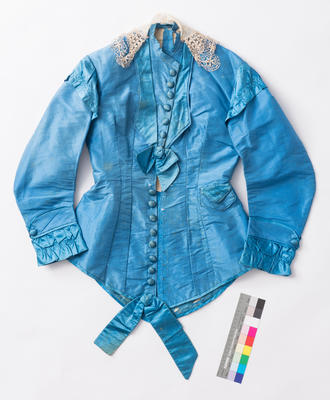Wedding gown
Production date
1876
Country
Australia
State/Province
Queensland
See full details
Object detail
Description
Two piece hand and machine sewn blue silk/silk satin two piece gown consisting of a skirt with vertical ruching, pleated hemline and bustle, and calico-lined jacket with added lace trim at collar, long sleeves featuring frilled shoulder and cuffs, self-covered buttons at centre front and cufss.
Classification
COSTUME Wedding
COSTUME Wedding woman
COSTUME Wedding woman
Maker
Production date
1876
Media/Materials description
Silk (possibly weighted)
Silk satin
Cotton
Metal
Rayon
Wool
Silk satin
Cotton
Metal
Rayon
Wool
History and use
This blue two-piece hand and machine-sewn wedding dress was worn by Mary Stuart for her marriage to Thomas Lorimer Smith, which took place on 24 May 1881 at the residence of her father, James Stuart.
James Stuart, born 1830 at Castle Douglas,Kirkudbrightshir,Scotland, was the first teacher at the new Frederick State School—later renamed Marburg State School—which opened on 18 March 1879. His daughter Mary Born at Fowlis Westor, Perthshire, Scotland, on 3 January 1860.
Mr Stuart retired from teaching 30 June 1880 and was appointed as a land valuer for the local Walloon Council after submitting a tender of £60 to secure the position. James Stuart died in Marburg, aged 64, on 3 Spetember 1894, one month after the death of his son, William Scott Stuart.
The Smith family established themselves in the Rosewood-Marburg district in the 1860s/early 1870s. Thomas' father, Charles, had arrived in Queensland from England in 1862, and in 1864 was joined by his wife and family. He established a saw mill at Sandy Creek, Walloon, on the outskirts of the Rosewood Scrub, in 1865, and c. 1866 took his eldest son, Thomas Lorimer Smith, into his saw milling business.
Mary and Thomas had 11 children. Little is known about Mary’s contribution to the Marburg community but she is described by living descendants as ‘stern’ and seems to have commanded a great amount of respect as the formidable matriarch of the Smith family. Mary and Thomas resided at Woodlands, one of the region’s oldest and most iconic mansions. Woodlands was designed by Ipswich architect George Brockwell Gill and built using locally sourced bricks and red cedar. Gill’s other notable works include the now demolished Brynhyfryd at Blackstone, Ipswich Girls’ Grammar School, and Ipswich Technical College.
Consisting of a silk jacket and skirt lined with cotton, with decorative silk satin buttons and garniture, the dress is typical of the classic bustle silhouette popular in the 1870s and 1880s and marks a departure from the fuller crinolines of the 1850s and 1860s. The frills, pleats and complicated drapery of the dress reflect the complexity of women’s dresses towards the end of the 20th century, made possible by the increased availability of textiles and innovative technologies such as the sewing machine.
Although white was a popular colour for wedding dresses throughout the Victorian period, coloured dresses were worn by even the wealthiest of brides.
James Stuart, born 1830 at Castle Douglas,Kirkudbrightshir,Scotland, was the first teacher at the new Frederick State School—later renamed Marburg State School—which opened on 18 March 1879. His daughter Mary Born at Fowlis Westor, Perthshire, Scotland, on 3 January 1860.
Mr Stuart retired from teaching 30 June 1880 and was appointed as a land valuer for the local Walloon Council after submitting a tender of £60 to secure the position. James Stuart died in Marburg, aged 64, on 3 Spetember 1894, one month after the death of his son, William Scott Stuart.
The Smith family established themselves in the Rosewood-Marburg district in the 1860s/early 1870s. Thomas' father, Charles, had arrived in Queensland from England in 1862, and in 1864 was joined by his wife and family. He established a saw mill at Sandy Creek, Walloon, on the outskirts of the Rosewood Scrub, in 1865, and c. 1866 took his eldest son, Thomas Lorimer Smith, into his saw milling business.
Mary and Thomas had 11 children. Little is known about Mary’s contribution to the Marburg community but she is described by living descendants as ‘stern’ and seems to have commanded a great amount of respect as the formidable matriarch of the Smith family. Mary and Thomas resided at Woodlands, one of the region’s oldest and most iconic mansions. Woodlands was designed by Ipswich architect George Brockwell Gill and built using locally sourced bricks and red cedar. Gill’s other notable works include the now demolished Brynhyfryd at Blackstone, Ipswich Girls’ Grammar School, and Ipswich Technical College.
Consisting of a silk jacket and skirt lined with cotton, with decorative silk satin buttons and garniture, the dress is typical of the classic bustle silhouette popular in the 1870s and 1880s and marks a departure from the fuller crinolines of the 1850s and 1860s. The frills, pleats and complicated drapery of the dress reflect the complexity of women’s dresses towards the end of the 20th century, made possible by the increased availability of textiles and innovative technologies such as the sewing machine.
Although white was a popular colour for wedding dresses throughout the Victorian period, coloured dresses were worn by even the wealthiest of brides.
Associated person
Registration number
H50692



